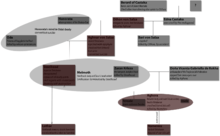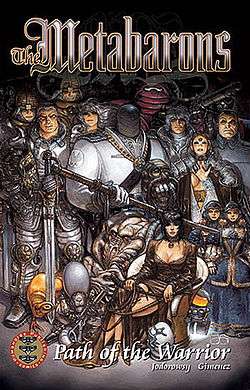Metabarons
| The Metabarons | |
|---|---|
|
Album cover of Path of the Warrior. | |
| Publication information | |
| Publisher |
Les Humanoïdes Associés (French) Arboris B.V. (Dutch) 'Norma Editorial, S.A. (Spanish) DC Comics (English) Humanoids (English) |
| Publication date | 1992–2003 |
| Main character(s) |
Othon von Salza Aghnar von Salza Steelhead Aghora Nameless |
| Creative team | |
| Writer(s) | Alejandro Jodorowsky |
| Artist(s) |
Juan Giménez Das Pastoras |
The Metabarons or The Saga of The Meta-Barons is a science fiction comic series relating the history of a dynasty of perfect warriors known as the Metabarons. The Metabarons series was written by creator Alejandro Jodorowsky and illustrated by Argentinian artist Juan Giménez. The series, published by Humanoïdes Associés, is complete, the last volume having been released at the end of 2003.
The first appearance of a Metabaron (chronologically the last of the Metabarons) was May 1981 in the Incal comic book series. This was followed by a series of prequels that concerned this character's origin, presented as the narration of the android Tonto to the android Lothar, of his masters' achievements. The series takes place over the course of several generations, and chronicles the life of each of the five Metabarons. The stories depict a space opera reminiscent of Greek tragedy, and heavily influenced by Frank Herbert's Dune novels.
Mythology
Rites
Every Metabaron is mutilated by his father in his youth so that his endurance to pain is tested, and receives a powerful mechanical body part as a replacement for the destroyed limb. In each generation, the son and heir must eventually face his father in a battle to the death. These battles have taken many forms, from hand-to-hand combat to space duels, and the succession is only achieved once the son succeeds in killing his father.
Bushitaka
The Bushitaka is the strict code of honor followed by the Metabarons; named after the Japanese bushido. It demands that the practitioners dedicate themselves to victory in all things at any cost, wherein the only alternative to victory is death, and even forsake their own family members in the pursuit of total victory.
Metabaronic weaponry
Each Metabaron draws upon an array of advanced weaponry. These include cybernetically-implanted lasers, nanotech nuclear warheads implanted in the body, swords which can disintegrate in bursts of flame, and advanced spaceships. Many of the Metabarons also exhibit powerful psychic abilities.
The dynasty

The story of the Metabarons begins on an isolated world, Marmola, on which a small tribe, ruled by Berard of Castaka, export huge blocks of marble. In addition, the planet is the native location of a blue, jelly-like substance, called epiphyte, whose properties defy gravity. The existence of the substance has been a sacred secret of the Castakas for many generations, until its revelation to save the life of Othon von Salza, the son-in-law of Baron Berard. Soon after the revelation of the epiphyte, the planet's orbit becomes a battlefield, with the treacherous Imperial Black Endoguard as the victors. At the end of the war, Othon and his son Bari are the only survivors of the Castaka tribe. The Imperial couple, rulers of the known galaxy, are astonished by the achievement of Othon and reward him; and Othon shows them where the epiphyte was hidden in exchange for a percentage of the new market for anti-G Technology, a new planet to which their palace would be transferred, and a gift for his son intended to restore the joy lost with his crippled legs. The emperor gives him a horse, an extinct species revived by genetic manipulation; but pirates steal the horse. Othon kills them in retaliation, but accidentally kills his son, and is castrated by an attacker. Othon thereafter invests a large part of his fortune in the development of the first 'metabaronic' weapons and begins the tradition of cybernetic implants; and later becomes a mercenary of extraordinary skill and power. By the destruction of 100,000 pirate vessels, he and his descendants receive the title of Metabaron, and the Imperial couple promise a gift. Later, a woman named Honorata offers that she can bear Othon a child if he places a drop of his blood in her uterus. With this done, two of Othon's servants try to commit suicide, taking the pregnant Honorata with them; but Othon injects a potion of epiphyte into Honorata. This deprives his son, Aghnar von Salza, of weight; wherefore Othon lets Honorata train Aghnar by herself. When Aghnar is seven years old, he defeats a machine set against him by his father; whereupon Othon continues his training. Honorata then confesses she was ordered to give birth to a hermaphrodite instead of a son, by the priestesses of Shabda-Oud. For her disobedience, the Shabda-Oud attempt her destruction. Othon, to assure his son's ability to avenge her, orders Aghnar to fight him to the death, and Aghnar seizes the title of Metabaron for himself.
The sole human in a hostile world, Aghnar befriends a single primatoid, and becomes its tribe's messiah. He then seizes a Shabda-Oud cetacyborg battleship with which to carry out his vengeance; but is distracted by the Cetacyborg's crew's original objective: to capture Princess Oda, to use her for the sisterhood's breeding experiments. After a telepathic confrontation with the sisterhood, Oda suffers debilitating injuries; whereupon Honorata, kept alive by her own mental powers, transfers her own soul to Oda, who thereafter bears Aghnar a son. Disgusted by his incest, Aghnar attempts to kill his son, whom Oda/Honorata gives a cybernetic head to replace his own, for which he is called Steelhead. Steelhead later kills his parents. At his claim to the title of Metabaron, the Princess Doña Vicenta argues that his offspring must be unworthy of the title. Therefore, Steelhead assumes the disembodied head of Zaran Krleza, the last poet in the galaxy. United in body and head (but somehow maintaining individual personas), Steelhead and Zaran become Melmoth, which declares Doña Vicenta as the object of his affections, and resurrects her father, along with a rare, titanic tree (both destroyed by Steelhead himself). Doña Vicente consents to the match; but the clone of her father attempts to take her by force, whereupon Vicenta gives him her eyes. Mollified, he permits Melmoth and Doña Vicenta to marry; but Melmoth discovers that Tonto, his robotic servant, has replaced her eyes by cybernetic sensors, and shuns her. Eventually, he reverts to the form and character of Steelhead, and takes care of his bride. When unable to preserve both of Vicenta's twin children alive, Steelhead removes the male twin's brain and implant it in the female child, and trains the androgynous Aghora would be trained as a warrior, who eventually faces his/her father in single combat to become Metabaron. To conceive an heir, he/she extracts the male cells from his/her own brain and implants them in his/her womb, thereby creating a male clone: later the Nameless Metabaron who reigns in Incal.
In the last chapter of the saga (Sans-Nom, le dernier Méta-Baron), Lothar, the faithful android to whom Tonto is relating the Metabaronic lore in the frame narration, is identified as Steelhead himself, kept alive by his conversion to a robotic existence. Recovering his personality, but not his full memories, after a brief confrontation in which he gives Nameless the iconic scarring in his eyebrow, he allies himself with a vampiric creature to enact his vengeance upon his descendant. Ultimately, he repents; whereupon Nameless has himself sterilized, and remains in self-pity until the Spirit of the Castaka family, embodied by the mark on his chest, prompts Nameless to become a force for good, protecting life whenever he can. With this new mission, the Metabaron becomes the unstoppable mercenary featured in the Incal.
Albums
French
The series has been published in French as follows:
La Caste des Méta-Barons
- Othon le Trisaïeul - (Othon the Great-Great-Grandfather) (1992)
- Honorata la Trisaïeule - (Honorata the Great-Great-Grandmother) (1993)
- Aghnar le Bisaïeul - (Aghnar the Great-Grandfather) (1995)
- Oda la Bisaïeule - (Oda the Great-Grandmother) (1997)
- Tête-D'Acier l'Aïeul - (Steelhead the Grandfather) (1998)
- Doña Vicenta Gabriela de Rokha l'Aïeule - (Doña Vicenta Gabriela de Rokha the Grandmother) (1999)
- Aghora le Père-Mère - (Aghora the Father-Mother) (2002)
- Sans Nom, le Dernier des Métabarons - (Nameless, the Last of the Metabarons) (2003)
A special volume, containing interviews with Jodorowsky and Giménez as well as sketches, unseen art, and a short story concerning one of the Metabaron's ancestors, called La Maison des Ancêtres (The House of the Ancestors) was released in 2000.
Castaka
This is a spin-off of the original series, it will consist of three albums. The artwork is by Das Pastoras because Juan Giménez is too busy with other projects.
- Dayal, le Premier Ancêtre - (Dayal, the First Ancestor) (2007)
- Les Jumelles Rivales - (The Rival Twins) (2013)
Les Armes du Meta-Baron
- Les Armes du Meta-Baron - (Weapons of the Metabarons) (2008)
Another spin-off by Travis Charest and Zoran Janjetov.
English
All the main French albums were reprinted in English in their original version by Humanoids. These include:
- Othon & Honorata (136 pages, 2004, ISBN 1-4012-0362-0)
- Aghnar & Oda (136 pages, 2004, ISBN 1-4012-0381-7)
- Steelhead & Doña Vicenta (136 pages, 2005, ISBN 1-4012-0642-5)
- Aghora & The Last Metabaron (128 pages, 2010, ISBN 1-59465-001-2)
Humanoids Publishing released 17 issues, published in 2000-2001. All were collected into censored trade paperbacks, with a fifth volume containing 4 short stories.
- Path of the Warrior (collects #1-5, 152 pages, 2001, ISBN 1-930652-47-X)
- Blood and Steel (collects #6-10, 136 pages, 2003, ISBN 1-930652-24-0)
- Poet and Killer (collects #11-14, 112 pages, 2002, ISBN 1-930652-23-2)
- Immaculate Conception (collects #15-17, 80 pages, 2003, ISBN 1-930652-93-3)
- Alpha/Omega (One-shot; collects The Crest of Castaka, The Last Metabaron, Incal: The Lost Pages, and a reworked version of Incal: The Lost Pages), 48 pages, 2002, ISBN 1-930652-41-0)
